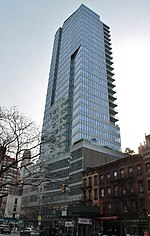76th Street station (IRT Third Avenue Line)
1878 establishments in New York (state)1955 disestablishments in New York (state)Former elevated and subway stations in ManhattanIRT Third Avenue Line stationsManhattan railway station stubs ... and 4 more
Railway stations closed in 1955Railway stations in the United States opened in 1878Third AvenueWikipedia page with obscure subdivision

The 76th Street station was a local station on the demolished IRT Third Avenue Line in Manhattan, New York City. It was originally built on December 9, 1878. The outer tracks served local trains and it had two side platforms. The center track was built as part of the Dual Contracts and was served by express trains. This station closed on May 12, 1955, with the ending of all service on the Third Avenue El south of 149th Street.
Excerpt from the Wikipedia article 76th Street station (IRT Third Avenue Line) (License: CC BY-SA 3.0, Authors, Images).76th Street station (IRT Third Avenue Line)
3rd Avenue, New York Manhattan
Geographical coordinates (GPS) Address Nearby Places Show on map
Geographical coordinates (GPS)
| Latitude | Longitude |
|---|---|
| N 40.772222222222 ° | E -73.95875 ° |
Address
3rd Avenue 1325
10021 New York, Manhattan
New York, United States
Open on Google Maps






